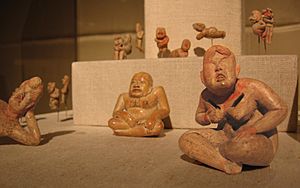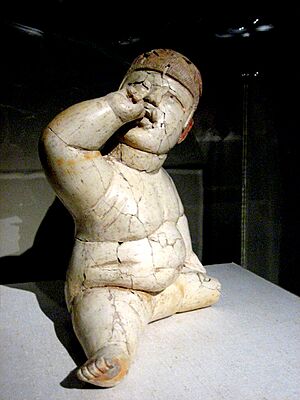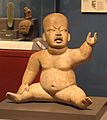Olmec figurine facts for kids

Olmec figurines are small statues made by people in Central America. They were created a very long time ago, from about 1000 BCE to 500 BCE. BCE means "Before Common Era," which is like saying "before the year 0."
Many of these figurines come from the Olmec heartland. This is a special area in the gulf region of modern-day Mexico. The figurines show the unique style of the Olmec culture. We don't know exactly how far the Olmec influence reached. So, some figurines might have been made by other groups who were inspired by the Olmecs.
Many figurines were found in old household trash or in areas used for building. Outside the Olmec heartland, some were also found in graves. Sadly, people who illegally dig up old sites often took these figurines. This makes it hard to know where many of them originally came from.
Most Olmec figurines are made from terracotta. Terracotta is a type of baked clay. It is quite fragile, so most figurines are found in pieces. Wooden statues have been found at a submerged site called El Manatí. However, no wooden figurines have been discovered yet.
The figurines that people know best are made from stone or special rocks. These include materials like jade, serpentine, greenstone, or basalt. Stone figurines are often carefully carved. Terracotta figurines usually have simpler designs.
What Do Olmec Figurines Look Like?

Olmec figurines show many different styles and designs. Here are some common ones:
- "Baby Face": This is a very common style in Olmec art, especially in early times. These figurines have round, baby-like faces.
- "Elongated Man": These figurines show a human figure in an unusual pose. They have thin arms and legs. Their heads often look stretched or changed.
- "Were-Jaguar": This is a popular theme found throughout all Olmec art. "Were-jaguar" means a mix of a human and a jaguar. These figurines often show features of both.
- Transformation Figurines: These figures show an animal changing into a human. They can also show humans wearing animal masks.
- Small Humans: Some figurines are small and look very realistic. They show human figures in natural poses.
- Dwarf Figurines: These are figurines that represent small, dwarf-like figures.
Gallery
-
An Olmec eagle transformation figure. It was made between the 10th and 6th centuries BCE. It is made of jade (albite) and has red cinnabar coloring. It is 4.5 in. (11.4 cm) tall.
Images for kids
-
A ceramic figurine showing typical "baby-face" characteristics, from the Snite Museum of Art.
See also
 In Spanish: Miniaturas olmecas para niños
In Spanish: Miniaturas olmecas para niños








